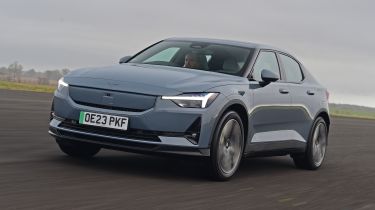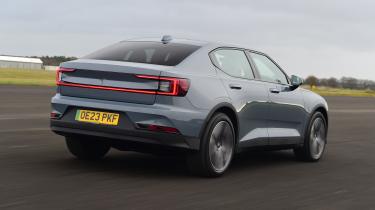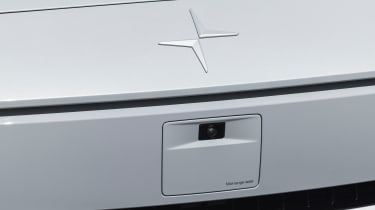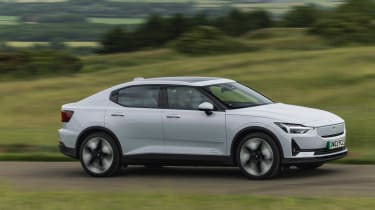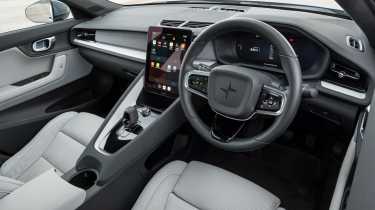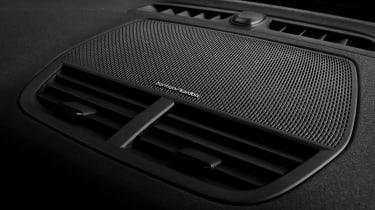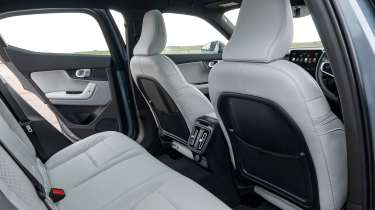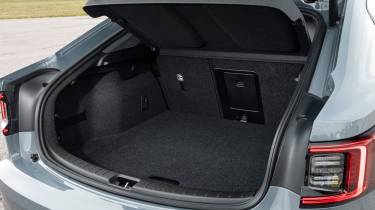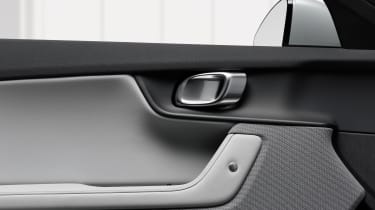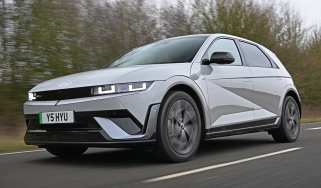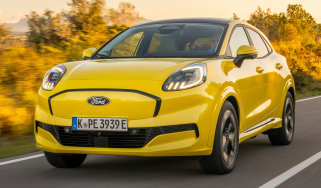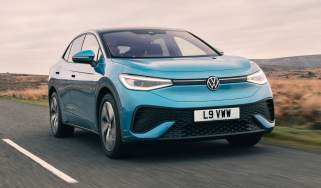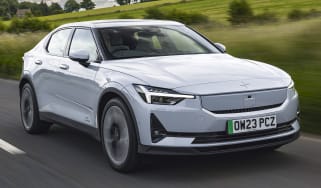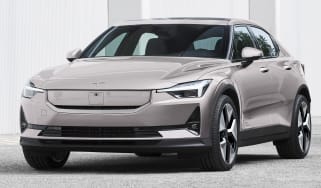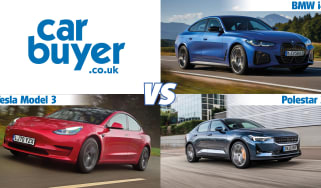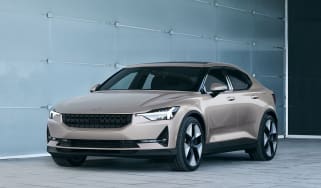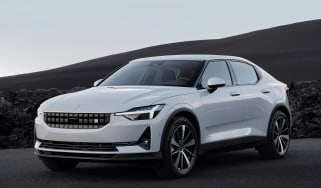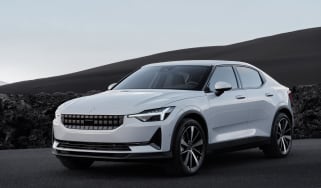Polestar 2 review – Tesla Model 3's fiercest rival?
"The Polestar 2 gets plenty of range and performance, and has one of the best infotainment systems in the business. It’s fun to drive, too, but a firm ride lets it down”
Pros
- Build quality
- Strong performance
- Long range
Cons
- Firm ride
- No dedicated charging network
- Tight rear passenger space
Verdict – is the Polestar 2 a good car?
Fast becoming one of the most convincing rivals to Tesla, the Polestar 2 is an attractive alternative for car buyers left unconvinced by the simplistic styling of the Tesla brand, and those who want to stand out a bit more. Even as more rivals like the BMW i4 from recognised manufacturers have entered the EV market, Polestar remains desirable thanks to its build quality, respectable performance and range figures that claim it can go further on a charge than the Tesla Model 3. Only a very firm ride lets the Polestar down; unless your commute is solely smooth motorway, we advise you try before you buy.
Polestar 2 models, specs and alternatives
Polestar started off as the performance arm of Volvo before becoming its upmarket electric offshoot. Now the companies are more distanced than they used to be, and Polestar has a stronger identity for itself than ever before, with a left-field, bolder image. The Polestar 2 was the brand’s first EV and sits on the same platform as Volvo’s C40 and EC40 cars as a result of the brands’ historic partnership.
The Polestar 2 came into a market dominated by the Tesla Model 3 during a time when other manufacturers were playing catch up, and as a result it’s been a fierce rival of that car for a number of years.
Right off the bat the Polestar 2 is arguably more interesting to look at than the Model 3 – familiarity breeds contempt, and the sheer number of Model 3s on the road can end up making you blind to their presence, which helps the 2 stand out. Other key rivals to the Polestar 2 include the BMW i4 and Hyundai Ioniq 6, all of which battle it out on the company-car scene thanks to favourable Benefit-in-Kind (BiK) tax breaks for zero-emissions vehicles.
In our mega test against its main rivals, the Polestar 2 came in fourth place, and that’s because it’s let down by sitting on the fence between being a keen driver’s car or comfortable cruiser – its harsh ride lets it down and yet it’s still not the most engaging EV to drive.
The 2’s design is simple, but attractive, and it was penned by one of Volvo’s former design chiefs, Thomas Ingenlath. A facelift in 2023 also brought a revised front end with a new body-coloured trim element where the fake grille used to be, but the overall design was largely the same on the surface. Improvements to the Polestar 2’s front-wheel drive configuration were welcomed, though – it became rear-wheel drive in single-motor guise, bringing an increase in range and improvements in handling.
Three versions of the Polestar 2 are now available: a Standard Range Single motor, a Long Range Single motor and a Long Range Dual motor – the latter is also available with the ‘Performance Pack’ that brings extra power and performance. Even the cheapest Polestar 2 is capable of 344 miles according to official tests – thanks in part to a bigger battery and a switch from front to rear-wheel drive for the 2023 update. The Long Range Single motor is the range champion, however, with this car managing up to 410 miles on a charge.
Charging peaks at 205kW (135kW for the entry-level version) using ultra-rapid public chargers, which can quickly add driving distance if you need to stop to charge on the motorway. Polestar offers owners access to more than 700,000 chargers across Europe, including the latest Tesla Superchargers which are now open to drivers of other EVs.
The performance of the range-topping Dual motor version is close to that of the quickest Tesla Model 3. It uses the same 82kWh battery and the Long Range Single motor model, with an extra motor sending power to all four wheels. This car produces 416bhp – catapulting the car from 0-62mph in 4.5 seconds. There's even an optional upgrade as part of the Performance Pack, which increases power to 469bhp. It corners well too, even if the ride can feel firm as a result of the stiff suspension. The Performance Pack also adds Ohlins dampers, Brembo front brakes, 20-inch forged alloy wheels and gold highlights for around £5,000.
The interior of every Polestar 2 is simple but attractive, with nicely chosen materials that give the car an inviting feel. Polestar is trying hard to position the brand as an option for everyone by offering a vegan-friendly interior, although the choice of sustainably sourced leather still exists as an option. The 11-inch touchscreen was the first to get Android's dedicated operating system and you won't need a key, as the car recognises the owner's smartphone. It's even possible to stream Prime Video and YouTube while parked up or charging.
| Trim levels | Power options |
|
|
Polestar 2 alternatives
The Polestar 2 is an interesting mix of saloon car and SUV, straddling the executive car and the premium compact electric SUV sectors. Buyers looking at these kinds of models have a range of options.
Range, charging & running costs
Polestar is clearly gunning for the Tesla Model 3 with its long range family car. There are multiple battery and motor combinations to choose from, the most usable of which will officially do more than 400 miles on a charge – 408, to be exact.
Since the Polestar 2 was facelifted, we’d actually recommend the cheapest Standard Range Single motor model, which still does up to 344 miles, but costs a significant £4k less than the Long Range car.
Polestar 2 range & charging
The Polestar 2 was facelifted in 2023, and with it came some significant changes to the battery and powertrain, followed by some minor tweaks for the 2025 model year. The basic Standard Range Single motor car is now rear-wheel drive (as opposed to front-wheel drive, as before) and features a 70kWh battery for up to 344 miles of range. This version will charge at up to 135kW if you can find a fast enough public charger – good for 10-80% in 34 minutes.
Upgrading to the Long Range Single motor model not only nets you a bigger 82kWh battery and maximum 410-mile range, it also opens up 205kW ultra-rapid charging – the same as the BMW i4 eDrive40. Despite the bigger battery, the car will charge 10-80% in 28 minutes.
The final model in the lineup is the Long Range Dual motor, which has the same battery and charging technology as the Long Range Single motor model. However, the extra weight and punchier performance means range drops slightly to 367 miles. Whichever you go for, this latest-generation battery and motor makes the Polestar 2 a highly usable electric car.
Cold weather conditions can negatively affect the range of electric cars, but the Polestar 2 can be specified with a heat pump. This neat device is more than three times more efficient than a traditional heater, which helps to maintain the car’s range in winter by helping to warm the cabin and optimise the battery temperature. The bad news is that this comes at a hefty extra cost as part of the Climate Pack, which includes other luxury additions you might not want to pay for – it would be better if the heat pump was sold as a standalone option.
To make Europe-wide public charging simpler, Polestar offers its Polestar Charge service, which enables access to a claimed 700,000 public chargers across Europe through one app. That’s an impressive number, but it has some way to go to beat Tesla's Supercharger network, which convincingly topped our Driver Power survey of chargepoint providers. However, the latest generation of Superchargers are now open to drivers of other EVs, including the Polestar 2, so Tesla’s charging advantage isn’t as big as it once was.
All Polestars get 11kW AC charging as standard, though you’ll need three-phase electricity to take advantage of that. If you’ve got this setup at home or work, charging the Polestar 2 takes between seven and eight hours; a more common 7kW wallbox will take between 10h45m and 12h30m depending on the battery you opt for.
VED (road tax) is free for the Polestar 2 until April 2025 and company-car drivers will enjoy a low BiK band. Three years of servicing and roadside assistance are included and the 2 is covered by a three-year warranty.
| Model | Battery size | Range |
| Standard Range Single | 70kWh | 344 miles |
| Long Range Single | 82kWh | 410 miles |
| Long Range Twin | 82kWh | 367 miles |
Electric motor, drive & performance
Step into the Polestar 2 and the high centre console cocoons you, resulting in a driving position that feels snug and sporty, despite the car’s high stance.
Both the Single and Dual motor models certainly grip well as they carve through longer corners, giving the driver plenty of confidence. You can tell the battery pack gives the car a low centre of gravity, and the instant shove of the electric powertrain in more powerful versions is certainly addictive. It may not match the Tesla Model 3 from 0-62mph but it’s more fun on a twisty road, especially since the switch from front to rear-wheel drive on single-motor versions. The polestar 2’s chassis has a sweet balance through the corners and body roll is minimal, even when you press on.
Our biggest issue is the Polestar’s firm ride. Around town you can feel every crease in the road, as the stiff suspension refuses to cushion deeper potholes. The car doesn’t settle on faster rural roads, either. It has a tendency to fidget, bouncing about with the various cambers and imperfections, and even if you spec smaller wheels, the ride is still uncomfortable. Still, even the Tesla Model 3 isn’t perfect in this respect, transmitting lots of high frequency vibrations through the cabin at lower speeds, though it settles down a little more than the Polestar on faster roads.
Another benefit to the revision from front to rear wheel drive in the facelifted cars is that the nose of single-motor models lurches up and down much less with heavy acceleration and regenerative braking, making it more comfortable for passengers in particular.
The Dual Motor Performance Pack version gets a software upgrade that brings an extra 53bhp. It’s notably quick, with a good response when you put your foot down. Even when we were tackling some challenging A and B roads, the Polestar 2’s forceful regenerative braking worked well in the corners, so we were able to drive with just one pedal effectively. The major drawback is that the Performance Pack’s ride is even harsher than the standard car’s, and we’re not sure whether this trade-off is worth it for everyday driving.
Although the Performance Pack brings adjustable dampers, making them softer or firmer is a pretty involved job – you’ll need a special set of tools and a space to jack the car up and take the back wheels off to tweak them – there’s no button to press in the cabin.
The Polestar 2 is a fine motorway cruiser too. It’s relatively quiet, and with plenty of power, quick overtakes are no trouble whatsoever. That long range means you’ll not be stopping very often, either.
0-62mph and top speed
Following a facelift for 2023, the entry-level, Standard Range Single motor Polestar 2 is rear-wheel drive and has 268bhp, managing 0-62mph in 6.4 seconds.
So far, we’ve only driven the Long Range Single motor, which is boosted to 295bhp for a 0-62mph time of 6.2 seconds. It feels like ample performance, with enough acceleration available to make light work of overtaking. It also handles just as well as the more expensive versions, although you can’t opt for the Performance Pack on either of the two single-motor models.
Step up to the Long Range Dual motor version and you get a power increase to 416bhp and four-wheel drive, with a huge, lag-free 740Nm of torque. This powertrain can get the EV from 0-62mph in just 4.5 seconds, but if you want even more performance you can opt for the Dual Motor with Performance Pack. This costs £5,000 but increases power to 469bhp, cutting the 0-62mph time to just 4.1 seconds.
This remains slower than the Tesla Model 3 Performance, but is still faster than most owners will ever need from a family hatchback. Power is produced evenly between the front and rear motors and weight is also distributed 50:50, so the Polestar 2 has an impressive sense of balance on the road.
Also included with the Performance Pack is suspension dampers by renowned motorsport firm Ohlins, along with uprated Brembo front brakes, 20-inch forged alloy wheels, gold valve caps and even gold seatbelts inside.
| Model | Power | 0-62mph | Top speed |
| Standard Range Single | 268bhp | 6.4s | 127mph |
| Long Range Single | 295bhp | 6.2s | 127mph |
| Long Range Twin | 416bhp | 4.5s | 127mph |
| Long Range Twin Performance Pack | 469bhp | 4.2s | 127mph |
Interior & comfort
Polestar has gone with a thick, sturdy feel for the Polestar 2, with chunky interior and exterior door handles and window switches. As a result, the 2 appears sold and well-built, and that could sway buyers put off by Tesla’s shaky build quality.
Given the Polestar 2 in range-topping form costs more than £50,000, you'd expect a plush interior, and the electric fastback delivers in most areas. There's a selection of attractive interiors, with finishes including black ash for the dashboard and embossed textile on the seats. It's also vegan-friendly, although it's possible to add sustainable leather as a £4,000 option.
Lost keys should be consigned to history, as 'Phone-as-Key' tech senses the driver's smartphone as they walk towards the car. This smart locking system can also allow collection drivers to pick up the car and delivery services to place items in the boot without the owner being present, so long as they are granted temporary access.
Infotainment and navigation
Sitting in the middle of the minimalist dashboard, the 11-inch portrait infotainment screen was the world's first to get Android's in-car infotainment software ‘Android Automotive OS’. It offers Google Assistant, Google Maps and apps, so should offer a great experience if you're an Android smartphone user, while Apple CarPlay is also available for those using an iPhone. While there are very few physical controls, there’s at least a knurled volume dial to make adjusting the sound more simple.
The resolution of the infotainment screen is excellent and using an Android system rather than one developed by Polestar seems like a masterstroke; it's surely a sign of what's to come for infotainment systems in future. It’s much clearer and more intuitive than the average manufacturer-developed operating system and seems like an obvious step when you think about what we've become familiar with through the use of smartphones. It's also compatible with various apps, including the Vivaldi web browser, Waze navigation, and from mid-2023 the YouTube and Prime Video streaming services, allowing occupants to watch media while parked up.
There’s also a digital driver’s display, which is simple but effective, and more in-depth information can be displayed by clicking a button on the steering wheel.
The dual-zone climate control is adjusted via a clear section at the bottom of the infotainment display. The absence of physical dials for this task is often a pain, particularly when driving, but it works well in the Polestar 2.
All versions come with the same basic kit list – so all you need to do is pick which battery and motor combination you prefer. Every car comes with LED front and rear lights, powered and heated front seats, the 11-inch touchscreen infotainment system, a rear camera, DAB radio, front and rear parking sensors, a hands-free powered boot lid, 19-inch alloy wheels, two-zone climate control and four USB-C sockets.
There are four optional packs that are available for all three models, following a restructure in 2024 to align the Polestar 2 with its 3 and 4 siblings. A 'Pilot pack' costs £2,000 and bundles upgraded 'Pixel' LED lights, a 360-degree camera, and several extra safety and driver assistance systems including adaptive cruise control.
The ‘Climate pack’ is new for the 2025 model year and brings a heat pump, heated rear seats, a heated steering wheel and heated windscreen washer nozzles. Also new is the ‘Pro pack’, which features 20-inch alloy wheels and gold-coloured seatbelts and valve caps.
The 'Plus' pack costs £4,000 and adds a Harman Kardon sound system, heated rear seats and a heated steering wheel, plus a panoramic sunroof and that aforementioned digital key, amongst other extras.
Only available with the Long Range Dual Motor version, the 'Performance' Pack costs £5,000 and includes the Ohlins adjustable dampers, lighter 20-inch alloy wheels, Brembo brakes, performance tyres, a high gloss black roof and gold detailing. It can also increase the power of its electric motors from 416bhp to 469bhp.
The pre-facelift and limited-run BST Edition 270 and BST Edition 230 models get these performance upgrades, as well as other key tweaks. All were sold in double-quick time, so getting your hands on one might prove tricky.
Individual Polestar 2 extras include floor mats, a load carrier for the roof and a tow bar.
Practicality & boot space
The Polestar 2’s cabin is roughly the same size as a Tesla Model 3’s, with plentiful room for front-seat passengers – despite the high centre console and driver-focused feel. The Polestar’s sloping roofline means there’s slightly less space in the back, however, while smaller rear door openings mean it’s perhaps not quite as family-friendly either.
It also seems slightly odd for an EV that there's a transmission tunnel that robs some rear space for the middle passenger – evidence that the Polestar 2's CMA underpinnings are shared with combustion-engined cars like the Volvo XC40. The optional panoramic sunroof bathes the interior in light but also eats into headroom slightly.
| Size comparison | |||
| Model | Length | Width | Height |
| Polestar 2 hatchback | 4,606mm | 1,859mm | 1,473mm |
| Tesla Model 3 saloon | 4,694mm | 1,849mm | 1,443mm |
| BMW i4 hatchback | 4,783mm | 1,852mm | 1,448mm |
| Hyundai Ioniq 6 saloon | 4,855mm | 1,880mm | 1,495mm |
Boot space
Total storage space for the Polestar 2, including the 'frunk' (a small storage compartment under the bonnet) stands at 440 litres. You get 35 litres at the front of the car, best reserved for the charging cables or the odd bags of shopping you don't want sliding around. There's a further 405 litres in the boot, which includes 41 litres under the boot floor. This total capacity puts it slightly ahead of the Model 3, which has 425 litres in total. Fold down the 40/60 rear seats and you free up 1,095 litres in the 2.
Even more importantly, the Polestar 2 has a hatchback rather than the saloon bootlid on the Model 3, meaning there's a much larger opening for loading bulky and awkwardly shaped items. The Tesla wins back points with its frunk, which is a more usable shape than the 2's.
| Boot space comparison | |
| Model | Boot space |
| Polestar 2 hatchback | 440 litres |
| Tesla Model 3 saloon | 425 litres |
| BMW i4 hatchback | 470/1,290 |
| Hyundai Ioniq 6 saloon | 401 litres |
Reliability & safety
Polestar is still a relatively niche brand in the UK, but with over 17,000 cars on the road, the days of relying on sister-company Volvo’s reliability and satisfaction data are over. Polestar featured in the 2023 Driver Power survey as a standalone brand – finishing a solid second overall. It didn’t feature in 2024, however, because too few Polestar owners responded to the survey.
Reliability
As mentioned above, Polestar finished second in the 2023 Driver Power owner satisfaction survey, with the Polestar 2 placing 17th out of 75 cars in the make/model rundown. While that’s undeniably impressive, we mustn’t take it at face value – a whopping 69% of drivers experienced problems with their car during the first year; more than any other brand.
And yet they still rated their cars highly for practicality and low running costs, as well as road holding and driving pleasure. Negatives – in addition to those first-year faults – include complaints about ride comfort. That’s something we also found to be problematic during our time with the facelifted car.
Safety
The car’s safety credentials benefit from the latest technology, including central airbags between the front passengers to further protect them in a collision. When the Polestar 2 was tested by Euro NCAP in early 2021, it scored the full five stars, with 92% and 89% ratings for adult occupant safety and child safety respectively. It also scored 80% for its vulnerable road user protection and 86% in the safety assist category.
One of the main safety features fitted to the Polestar 2 is the Volvo Car Group’s latest driving assistance technology, which can help accelerate, brake and steer the car at speeds of up to 81mph. A myriad of sensors monitors the area around the car, helping avoid or brake if a pedestrian, cyclist or vehicle is detected. The battery is also enclosed in an aluminium case to protect it from damage.
